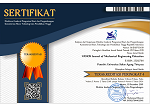TENSILE STRENGTH AND VIOLENT CONNECTION LAS STEEL ST 40 WITH EMPLOYING VARIATIONS ELECTROTECHNICS AND VARIATIONS OF CURRENT
Abstract
Shield Metal arc welding (SMAW) is one of ways which are usually used for welding steel low carbon. The quality of the welding connection can be grouped by using pull testing, and Vickers method. This study aims to know the strength of pulling and hardness welding connection with the variation of electrodes and current. This study used carbon steel ST 40 with an electrode which is used E 6010 and E 7016 with the current variations 80 ampere, 90 ampere and 100 ampere. The result produced the result to the power of certainly drag out from a current of 80 a use electrodes 6010 was recorded at 34,92 kg / mm2. Of tensile strength with a current of 90 a shall be 37.43 kg / mm2 and tensile strength the use of a 100 a shall be 40,63. The force of attraction to the electrode 7016 is promoting the creation of ampere 80 is 33,11 kg / mm2, ampere 90 of tensile strength him it is the same 35,57 kg / mm2 while using ampere 100 of tensile strength that is produced is 37,76 kg / mm2. The difference between the value of the force of attraction for a current is 80 a 1,81 kg / mm2. A current of 90 a 1,86 kg / mm2 and with a current of 100 a 2,87 kg / mm2 for the material structure image on the fault of drag monitoring shows the material is ductile because the fault looks low and high.
Keywords
Full Text:
PDFReferences
ASM Handbook, 1995, Welding, Brazing, and Soldering, Vol 6, ASM International, USA.
Callister, W.D.Jr, Rethwishch, D.G., 2010, Materials Science and Engineering, An Introduction, 8ed, John Willey & Sons, Inc., New York.
Dieter, G.E., 1988, Mechanical Metallurgy, SI Metric ed., McGraw-Hill, Singapore
Howard B.C., Modern Welding Technology. 4nd edition, Prentice Hall,New Jersey, 1998. Universitas Brawijaya Malang.
Imam P. J.S, Sarjito (2008.). Analisis Kekuatan Sambungan Las Smaw (Shielded Metal ARC Welding) Pada Marine Plate ST 42 Akibat Faktor Cacat Porosita dan Incomplete Penetrasion. Penerbit Universitas Diponegoro. Semarang.
Lancaster, J.F., 1999, Metallurgy of Welding, 6 th ed., Abington Publishing, Cambridge.
Messler, R.W. Jr., 1999, Principles of Welding; Processes, Physics, Chemistry, and Metallurgy, John Willey & Sons, Inc., New York.
Meyers, M.A., Chawla, K.K., 1999, Mechanical Behaviour of Materials, Prentice-Hall International, Inc., New Jersey.
Pribadi, Y. Siswanto, E. Soenoko, (2017) Pengaruh Posisi Pengelasan dan Jenis Eletroda Temper Bead Welding Terhadap Ketangguhan Hasil Las SMAW Pada Baja SS 41. Penerbit Universitas Brawijaya.Malang.
Saripuddin M. Umar Lauw D. (2013). Pengaruh Pengelasan Terhadap Kekuatan, Kekerasan dan Struktur Mikro Baja ST 42.Penerbit ILTEK. Makassar.
Sanhiarsa,IG. Budiarsa,I.NY. (2008). Pengaruh posisi pengelasan dan Gerakan Elektroda Terhadap Kekerasan Hasil Las Baja JIS SSC 41. penerbit Cakram. Denpasar.
Timings, R, L. 1992. Engineering Materials. Volume 2. Penerbit Logman Group UK limited Malaysia.
Rusianto & Sigit. (2002), Pengaruh Temperatur Pemanasan Terhadap Kekerasan dan Ketebalan Lapisan pada Chromizing Baja Karbon Rendah, Jurnal Teknologi Industri, Vol.VI No,2 April 2002.
Weman, K., 2012, Welding processes handbook, 2nd edition, Woodhead Publishing Limited, p. 191
Wiryosumarto, H., Okumura, T., 1991, Teknologi Pengelasan Logam, Cetakan 5, Pradnya Paramita, Jakarta.
Wijoyo, Bayu Kartiko Aji. (2015), Kajian Kekerasan Dan Struktur Mikro Sambungan Las Gmaw Baja Karbon Tinggi Dengan Variasi Masukan Arus Listrik. 2015. Fakultas Teknologi Industri, Program Studi Teknik Mesin Universitas Surakarta.
DOI: http://dx.doi.org/10.30870/vanos.v3i2.4116
Refbacks
- There are currently no refbacks.

This work is licensed under a Creative Commons Attribution 4.0 International License.


.png)
.png)
